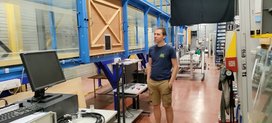
Around Kolmogorov's theory. Meeting of turbulence researchers in Lille, 2023
Over the past three summer weeks, i.e. from 18 June to 7 July this year, the third edition of the Lille Turbulence Program 2023, organized by the Laboratoire de Mécanique des Fluides de Lille (LMFL)-Campé de Fériet in France, took place. The event brings together dozens of turbulence researchers from all over the world, dealing in particular with non-stationary flows. Therefore, the meeting could not miss the representation from our Department of Atmospheric Physics and Laboratory of Fluid Mechanics, consisting of Marta Wacławczyk, Stanisław Król, Jakub Nowak, and Szymon Malinowski.
Turbulence researchers meet annually at the workshop in Lille to present and discuss their work and research results, initiate new developments, and collaborate on experimental and numerical databases of turbulent flows. During the event, participants are able to use LMFL's experimental facilities, including a 20-meter wind tunnel, within the CONTRAERO research platform of the University of Lille. This platform is made up of 4 tunnels with different characteristics, allowing detailed research to be carried out, from academic setups to validation of industrial solutions. Our researchers from the Atmospheric Physics Department, with the support of the Mechanical Workshop of the FUW Institute of Experimental Physics, have also recently built a wind tunnel in the IGF FUW Fluid Dynamics Laboratory, which will have its official premiere at the Science Festival in September 2023.
The theme of both the entire program and the individual workshops of the Lille Turbulence Program 2023, which took place during the first days of the meeting, was non-equilibrium turbulence, in which deviations from Kolmogorov theory are observed. This is because, according to Kolmogorov's theory, energy delivered to the largest vortex scales is transported at a constant rate from large vortices to smaller and smaller ones, in a process called an energy cascade. At the end of the cascade, after reaching the smallest vortex scales, the energy of the fluid motion is converted into heat. Turbulence imbalance occurs when the rate of energy transfer between vortex scales is not constant. This occurs, for example, when the energy supplied to the large vortices is rapidly reduced and turbulence begins to disappear.
Measurements by our researchers and analyses of studies from previous years indicate that the turbulence occurring in the atmospheric boundary layer and in clouds is of this nature (Nowak et al. [ACP, vol. 21, 2021], Waclawczyk et al. [JAS, vol. 79, 2022]). Similar observations have been made by various researchers in their laboratory experiments, in the aforementioned wind tunnels. However, there is a lack of a consistent theory that is broadly applicable to conditions where the assumptions of the former Kolmogorov theory are not met. The aim of the program was therefore to discuss experimental results and theoretical concepts, and to establish collaborations that could one day lead to the formulation of a good theoretical description of such non-equilibrium turbulence situations.
The workshop on the first three days of the meeting had the character of a small conference with presentations of 40 min each. During the workshop, the team of atmospheric physicists from the IGF FUW was represented with presentations by Marta Wacławczyk and Szymon Malinowski. The rest of the program consisted of more informal discussions and presentations of current research results. There was also one joint seminar each afternoon, with a different speaker each day, including Jakub Nowak from the IGF FUW team. Several researchers also used the time to conduct experiments in the LMFL wind tunnel.
Scientific consultation:
dr inż. Marta Wacławczyk
dr Jakub Nowak
Originally published on - July 7, 2023, 11 a.m.
Last update on - June 26, 2024, 11:04 a.m.
Publisher - Dąbrówka Stępniewska
PHOTO GALLERY

